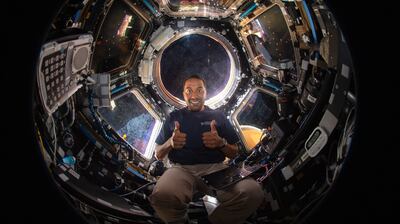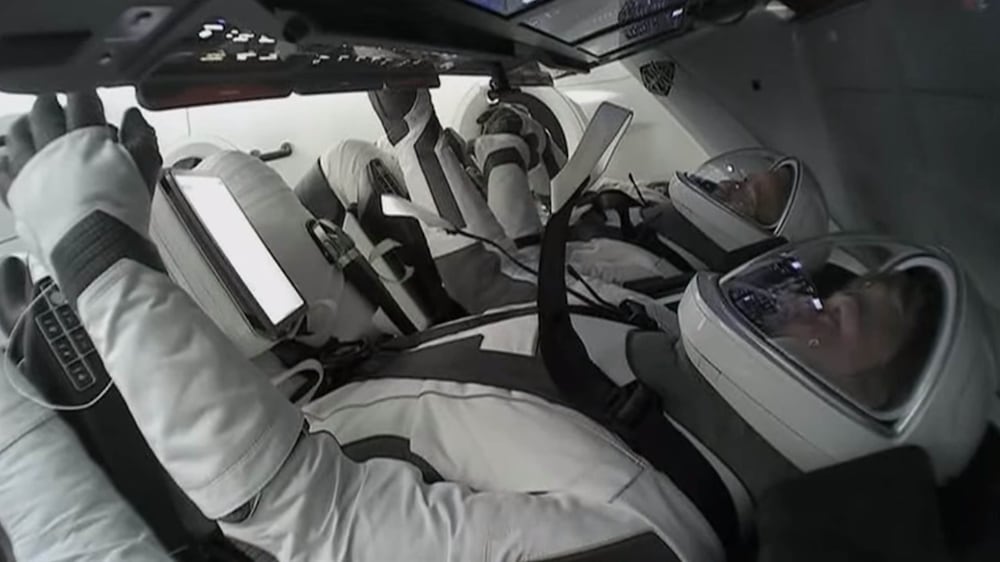Two Saudi astronauts are heading back to Earth after spending eight days on the International Space Station.
Rayyanah Barnawi and Ali Al Qarni made history as the first Saudi astronauts to go on a mission to the orbiting outpost.
Ms Barnawi, 33, a research scientist, is the first female Arab astronaut to go to space.
A SpaceX Dragon capsule is carrying the two Saudis and two American astronauts back home, with a parachute-assisted splashdown off the coast of Florida expected on Wednesday at 7.10am, UAE time.
The spacecraft, which is also carrying 136 kilograms of completed science experiments, hardware and personal items, undocked from the orbiting outpost at 7.05pm on Tuesday to begin the 12-hour journey.
Ms Barnawi delivered an emotional farewell speech on the ISS a day before their departure.
“Every story comes to an end, and this is only the beginning of a new era for our country and our region,” she said.
Mr Al Qarni, 31, thanked his colleagues aboard the station, including UAE astronaut Sultan Al Neyadi, who is there on a six-month mission.
The fighter pilot had duties to complete on departure day, including closing the hatch from inside the Dragon capsule for a timely undocking.
“You are such an amazing inspiration and I have learnt a lot from you,” he told his fellow astronauts on Tuesday.
“And I've enjoyed my time here and hopefully in the future we will be back on another trip very soon.”
Ms Barnawi and Mr Al Qarni were the first Saudi astronauts to go to space in nearly 40 years, after Prince Sultan bin Salman launched on a Nasa’s Space Shuttle in 1985 for a week-long trip.
Science investigations aboard the ISS

They carried out several science experiments during their time on the ISS, including ones focused on life sciences and weather technology.
The science community in Saudi Arabia had the opportunity to send their experiments with the astronauts.
Ms Barnawi, who has a decade of experience in stem cell research, carried out studies on human immune cells and their inflammatory response in microgravity.
Researchers from the Saudi Arabia's King Faisal Specialist Hospital and Research Centre sent white blood cells that Ms Barnawi treated with a substance to stimulate an inflammatory response.
The experiment was carried out in parallel with experiments on the ground, to help scientists measure the difference in results. The findings could help researchers better understand the immune system and develop potential therapies for inflammatory diseases in space and on Earth.
Dr Al Neyadi assisted her with the research.
Mr Al Qarni also had a busy schedule, with research that involved studying different cloud seeding techniques in microgravity conditions.
He mixed salt crystals and moist air in a reaction chamber to see if water droplets would form.
Capturing Saudi Arabia from space
The two Saudi astronauts also spent much of their time on the ISS carrying out outreach activities.
They spoke with school pupils across the kingdom via pre-recorded videos, livestreams and radio calls.
They were also photographers from the cupola, a panoramic observatory on the station, capturing many images of their home country.
“The whole kingdom is shining. Here you can see Makkah,” Ms Barnawi said in a video posted on her Twitter account on Friday. She has more than 77,000 followers.
Mr Al Qarni shared a night-time image of the Saudi capital Riyadh to his 65,500 Twitter followers.
Possibly first of many space missions for Saudi Arabia
The Saudi Space Commission – Saudi Arabia's space agency – is hoping that this is the first of many astronaut missions by the kingdom.
Saudi Arabia launched a long-term astronaut programme last year and is aiming to send its citizens on long-duration flights in the future.
The kingdom also has its sights set on missions to the Moon and Mars.







